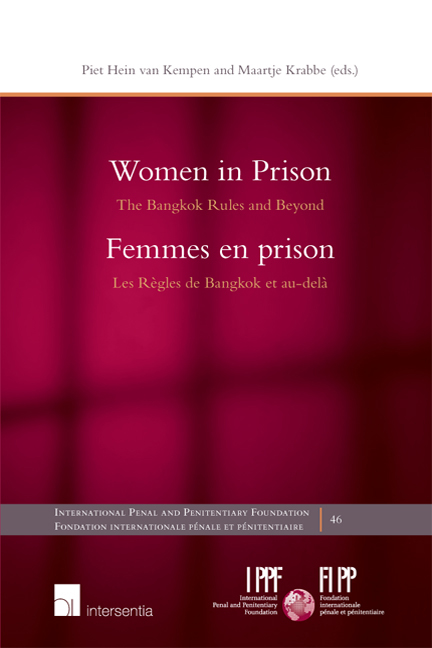Book contents
- Frontmatter
- Foreword
- Avant-propos
- Acknowledgements
- Remerciements
- Contents
- Part I Introductory Synthesis and Analyses: 1ÈRE Partie Synthèse ET Analyses Introductives
- Part II Themes: 2ÈME Partie Thèmes
- Part III National Reports: 3ÈME Partie Rapports Nationaux
- Women in prison in Argentina
- Women in prison in Australia
- Women in prison in Austria
- Women in prison in Brazil
- Women in prison in England and Wales
- Women in prison in Finland
- Femmes en prison en France
- Women in prison in Germany
- Women in prison in Greece
- Women in prison in Ireland
- Femmes en prison en Italie
- Women in prison in the Netherlands
- Women in prison in New Zealand
- Women in prison in Poland
- Women in prison in Portugal
- Women in prison in Russia
- Women in prison in South Africa
- Women in prison in Spain: their criminological and social invisibility
- Femmes en prison en Suisse: la situation des femmes prévenues et condamnées
- Women in prison in Taiwan
- Women in prison in Thailand: implementation of the UN Bangkok Rules in the Thai criminal justice system
- Femmes en prison en Turquie
- Women in prison in the USA
- Appendix The Bangkok Rules: Annexe Règles De Bangkok
- The International Penal and Penitentiary Foundation: History and Purpose
Women in prison in Portugal
from Part III - National Reports: 3ÈME Partie Rapports Nationaux
Published online by Cambridge University Press: 25 September 2018
- Frontmatter
- Foreword
- Avant-propos
- Acknowledgements
- Remerciements
- Contents
- Part I Introductory Synthesis and Analyses: 1ÈRE Partie Synthèse ET Analyses Introductives
- Part II Themes: 2ÈME Partie Thèmes
- Part III National Reports: 3ÈME Partie Rapports Nationaux
- Women in prison in Argentina
- Women in prison in Australia
- Women in prison in Austria
- Women in prison in Brazil
- Women in prison in England and Wales
- Women in prison in Finland
- Femmes en prison en France
- Women in prison in Germany
- Women in prison in Greece
- Women in prison in Ireland
- Femmes en prison en Italie
- Women in prison in the Netherlands
- Women in prison in New Zealand
- Women in prison in Poland
- Women in prison in Portugal
- Women in prison in Russia
- Women in prison in South Africa
- Women in prison in Spain: their criminological and social invisibility
- Femmes en prison en Suisse: la situation des femmes prévenues et condamnées
- Women in prison in Taiwan
- Women in prison in Thailand: implementation of the UN Bangkok Rules in the Thai criminal justice system
- Femmes en prison en Turquie
- Women in prison in the USA
- Appendix The Bangkok Rules: Annexe Règles De Bangkok
- The International Penal and Penitentiary Foundation: History and Purpose
Summary
INTRODUCTION
This chapter aims at discussing the historical evolution of women's criminality and imprisonment in Portugal. Though focusing on women, whenever possible a comparison with men is brought into the discussion.
Portugal is no exception to the worldwide imbalance between men and women's incarceration rates. Women have consistently been the minority among the population behind bars. Currently, as well as until the 1990s, they represent less than 6%. However, after the democratic revolution in 1974 (which decriminalised one of the main causes of women's imprisonment during the dictatorship: prostitution), this proportion rose steeply by the second half of the 1990s, up to nearly 10% by the end of the century - one of the highest rates in the European Union (EU).
In fact, during the 1990s the total population behind bars (men and women) registered an unprecedented increase, and attained the highest carceral rate per 100,000 inhabitants (145) in the EU. One of the features of this substantial change in prison population was its massive provenance from the same lowincome urban territories. As a result, co-prisoners are often neighbours, relatives or previous acquaintances, an aspect that altered the social world of the prison. This was both a consequence of selective drug control (intensive law enforcement targeting specific areas) and of the workings of the Portuguese retail drug economy (see section 4.2.3 below).
Although this change spanned both male and female prisons, it has been more concentrated - and therefore more salient - in the latter. Its prominence in women's institutions stems partly from the relative homogeneity of their population. In the 1990s, the variety of offenses behind women's imprisonment was sharply reduced. Although the population of male prisoners is also fairly homogeneous (property offenses and drug-related crimes together account for the majority of convictions), its internal distribution is more balanced than that of its female counterpart, which concentrates overwhelmingly on drug trafficking. As an example, analysed in Cunha's study documenting these shifts during the 1990s: in 1997, 46% of men were imprisoned for property offenses and 34% for drug-related crimes, as against 16% and 69% in the female case. Women are proportionally more likely to be sentenced to imprisonment for drug-related crimes than men.
- Type
- Chapter
- Information
- Women in PrisonThe Bangkok Rules and Beyond, pp. 613 - 644Publisher: IntersentiaPrint publication year: 2017
- 4
- Cited by



